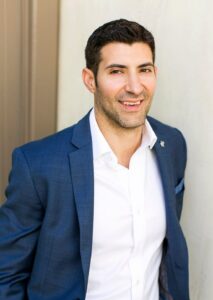Smita Wadhawan Of SimplePractice On How to Effectively Leverage The Power of Digital Marketing, PPC, & Email to Dramatically Increase Sales
An Interview With Fotis Georgiadis
Mind your reputation by being intentional about the moves you make and the projects you take, from early on in your career. Prioritize learning and look for opportunities to step out of your comfort zone. Get comfortable being uncomfortable, and remember that every new assignment and role is an opportunity to establish your reputation as a fast learner who leans in and delivers high-quality work. You’ll be surprised how many doors open for you when you have a stellar reputation.
Marketing a product or service today is easier than ever before in history. Using platforms like Facebook ads or Google ads, a company can market their product directly to people who perfectly fit the ideal client demographic, at a very low cost. Digital Marketing tools, Pay per Click ads, and email marketing can help a company dramatically increase sales. At the same time, many companies that just start exploring with digital marketing tools often see disappointing results.
In this interview series called “How to Effectively Leverage The Power of Digital Marketing, PPC, & Email to Dramatically Increase Sales”, we are talking to marketers, advertisers, brand consultants, & digital marketing gurus who can share practical ideas from their experience about how to effectively leverage the power of digital marketing, PPC, & email.
As a part of this series, I had the pleasure of interviewing SimplePractice CMO Smita Wadhawan.
Smita Wadhawan joined SimplePractice in September 2021 as the company’s first Chief Marketing Officer. Before joining SimplePractice, Wadhawan served as Head of SMB Growth Marketing for GoDaddy, where she led marketing strategy and campaigns to support each stage of the customer lifecycle. She has also served as the Director of Consumer Product Marketing for PayPal and held consumer and acquisition marketing leadership positions for Visa and Intuit.
Thank you so much for joining us in this interview series! Before we dive in, our readers would love to “get to know you” a bit better. Can you tell us a bit about your ‘backstory’ and how you got started?
I fell in love with marketing when I was 15 or 16. As a young girl growing up in India, I saw a television commercial for a bank selling home loans. I found myself glued to the television screen, as the commercial made a relatively boring product seem captivating and emotional through brilliant storytelling.
It was at that moment that I realized the power of storytelling, and I knew that I wanted to do something similar.
My journey toward doing the kind of marketing I love today was not as straightforward as I would’ve hoped. I went to business school to study marketing, and right after my MBA, I started working with General Electric in the consumer finance division. That’s when I saw the other side of marketing, which had more to do with data and numbers.
I found my sweet spot in between the art and science of marketing by beginning with storytelling, and then layering in data.
Can you share a story about the funniest marketing mistake you made when you were first starting? Can you tell us what lessons or ‘takeaways’ you learned from that?
I’ve made many mistakes, and not just in marketing. I used to envy how some people’s careers seemed to just follow an upward trajectory.
In reality, it’s not that these people never misstep, but rather that they rarely linger on their own mistakes. This realization changed my perspective significantly.
My first job in the U.S. was at PayPal. Early in my time there, I accidentally sent an email drop to a very long list of the wrong customers.
I was almost in tears when I realized the mistake. When I told my boss, fearing the worst, he was perfectly composed and replied in a calm voice, “Listen, we aren’t saving lives. Let’s go to the customer service team and tell them they might be getting some calls, and apologize for the mistake we made. Then, let’s figure out how we can be more clear in our briefings going forward.”
The situation, and his reaction, taught me an impactful lesson that I was fortunate to learn early in my career, about forgiveness and turning mistakes into learning opportunities.
None of us are able to achieve success without some help along the way. Is there a particular person who you are grateful towards who helped get you to where you are? Can you share a story?
I have been very fortunate. As a woman of color, creating a career in marketing hasn’t been easy, and I’ve had my fair share of naysayers. But I’ve also been very fortunate to have found mentors who have been generous with their coaching and support.
One person who really stands out to me was the Chief Operating Officer when I was at GoDaddy — Andrew Low Ah Kee. He was a transformational mentor to me. I had been working on the brand marketing side for some time, when he told me he wanted to move me to the website business. The company had big goals for that business and needed a strong leader. I felt hesitant. I truly loved working on brand marketing, and I knew that working in the website business was going to involve a lot of performance marketing, which I wasn’t very comfortable or familiar with at that time.
I expressed my doubts about taking on this new role, and his response was, “You won’t be alone. We’ll work on this together.” Knowing he believed in me and would support me helped me decide to take on the role, and in six months I knew as much about performance marketing as many people who had been doing it for years. I got there through a growth mindset and by doing everything I could to learn about this formerly unfamiliar area of marketing — and because Andrew worked with me and was such a great coach.
What do you think makes your company stand out? Can you share a story?
I think what differentiates SimplePractice is that we truly are committed to our customers. We make real customer feedback a part of our conversations, and consider the specific needs of different sectors of our customer base. A lot of companies would say that they prioritize the customer, but they don’t really keep the customer in the room when they’re making decisions. I would say SimplePractice takes steps to ensure that we do, and we do it exceptionally well.
Our culture is another standout to me. People here are very passionate about the mission, and they truly believe that we’re making a difference in the lives of our customers. They can see the impact that we’re having on our customers’ lives. I think their passion and love really shows, and creates a culture of accountability and collaboration that anchors our work to our customers.
You are a successful business leader. Which three character traits do you think were most instrumental to your success? Can you please share a story or example for each?
The growth mindset that made my transition from brand marketer to performance marketer possible is absolutely one of my biggest assets.
I also hold myself to very high standards. I don’t compete with people around me, or my peers. I’m just competing with myself, to be the very best version of myself. That perspective helps me hold myself accountable to doing great-quality work and pushing myself to the next level. It also helps me take on long-term challenges, when solutions aren’t immediate.
The third thing I’d say is that I’m extremely determined. When I really care about something, my willpower is iron-strong and there’s nothing that can deter me. At certain points in my career, it would have been very easy for me to give up. However, my sense of determination, and the fact that I was able to look around and see that I wasn’t the first woman doing this, helped push me forward.
Are you working on any exciting new projects now? How do you think that will help people?
I’m excited about the journey we’re undertaking to tell our brand story in a unified way across these varied segments, to help connect more people with our offerings.
Although SimplePractice’s roots are as a software for behavioral health professionals, practitioners across other health and wellness verticals are signing up as well. The organic influx of interest from a range of health and wellness professionals in trusting us to help them manage their businesses is a testament to the passion and purpose of our brand. Whether they’re setting up their own practice for the first time or trying to take an existing practice to the next level, we know that the value we offer our customers can make a huge difference. Whether they’re in behavioral health, occupational therapy, dietetics, or any other field, we want to support a wider variety of professions across the health and wellness industry.
With the launch of our consumer business Monarch, we’re able to help not only mental health practitioners, but those seeking care, too. Such dual-purpose networks are becoming more and more common. To me, this is a major opportunity to democratize mental healthcare and help make it more accessible to all.
I’m also very excited about investing in giving back to our customers through customer community work that’s underway.
Ok super. Now let’s jump to the main questions of our interview. As we mentioned in the beginning, sometimes companies that just start exploring with digital marketing tools like PPC campaigns often see disappointing results. In your opinion, what are a few of the biggest mistakes companies make when they first start out with digital marketing? If you can, please share an example for each.
I think the biggest mistake companies sometimes make is thinking of digital marketing as very lower-funnel. It’s easy to say, “we’re going to invest in SEM.” But the truth is nobody will click your ad if they don’t know about your brand. Digital marketing works best when considered as full-funnel.
Similarly, when it comes to Facebook marketing, for some of those seemingly lower-funnel campaigns to work, you really have to lead the customer down the whole journey.
Think about the journey from awareness, to consideration, and then closing the sale. I see a lot of companies just thinking about closing the sale, and the messaging they end up producing shouts “buy me now!” which can be simplistic and less engaging. Instead they should be focusing on guiding the customer through the entire story, using journey-based creative and media strategies.
If you could break down a very successful digital marketing campaign into a “blueprint”, what would that blueprint look like? Please share some stories or examples of your ideas.
A successful digital campaign starts with a good brief. Creative can only do beautiful creative work, and media can only do effective media planning, if you give them a strong business brief. Oftentimes, however, I see marketing teams circumvent the process of ensuring their brief is strong.
To avoid this, have a discussion to align on the business brief. Establish: what are the goals of the campaign? Who’s the target audience? What messaging do we want to focus on? How does the customer organically encounter the brand? What is the customer journey? Where are we losing, and winning, along that journey?
The more information marketers can share at the business brief stage, the more ammunition creative has to create a successful campaign. Similarly, if the media team understands the customer journey, they can plan media that complements it. For example, going with the assumption that everyone is on Facebook might not always work, maybe Reddit is a massive channel for your brand. It varies from one brand to another. Sharing those insights with the media team will help them devise a campaign that intersects at the media points where the customer organically shows up. Bring as much insight as possible, and do your homework.
You also want to avoid planning channel by channel, because it creates silos, rather than an integrated campaign and customer experience. Ask: What’s the story we want to create at the start of the journey to raise awareness? Then, how do we want to lead customers down the path to the consideration stage, when they’re comparing us to alternatives? Then, how do we make them choose us? At every stage of the journey, creative should deliver on the specific goal.
While the campaign may have a singular objective the entire time, each stage should have its own KPIs, as should each type of media that delivers at that stage
Let’s talk about Pay Per Click Marketing (PPC) for a bit. In your opinion which PPC platform produces the best results to increase sales?
Google is the king. Everywhere I’ve worked, Google has had a massive share of the marketing budget, because last click makes it so easy to attribute success. When it comes to search, they have tools that make it easy for marketers to manage campaigns.
Can you please share 3 things that you need to know to run a highly successful PPC campaign?
The world of PPC is very competitive. Google is constantly iterating on its algorithms to make them more effective. I see a lot of search teams approach campaigns with the mindset that they can “create it and then forget it,” but that’s not how search works. Even though you can set up rules to automate the process to some extent, Google’s changing algorithm and the shifting landscape of customer preference mean you must constantly monitor performance and figure out new ways to optimize.
The second suggestion I would make is, make sure you’re harnessing the power of testing. You can test across multiple parameters when it comes to PPC, from bidding strategies to ad copy to landing pages. As a marketer, you must think about each aspect of the campaign, and consider what can be improved, and then test for those specific metrics.
It’s also vital that as you go about your testing, you’re setting up solid experiments. You want to test expertly and deliberately. I often see teams fail because the experiments haven’t been set up the right way. If the test topic is relevant but the methodology, hypothesis, or strategy are unclear, you still won’t learn anything useful.
Let’s now talk about email marketing for a bit. In your opinion, what are the 3 things that you need to know to run a highly successful email marketing campaign that increases sales?
If you’re an email marketer, honing your channel expertise is crucial, but it’s also equally essential that you have a solid understanding of experimentation methods. Marketing nowadays is still about the storytelling that made me fall in love with it in the first place, but it’s also become more of a science than an art. Any marketer must be able to understand experimentation.
In email marketing, there are many things that could be tested — subject lines, body copy, target list, CTAs, images, creative, and so on. You have to know what you’re testing, why, and what metric you’re trying to improve.
It’s also key that you understand your existing customers’ behavior, because email marketing mainly targets existing customers. Oftentimes marketers will just send emails and it will end up being an inside-out marketing approach that doesn’t necessarily intersect customers based on their need states. You want to understand what your customers look like, where they’re shopping and how often, and what their next need will be. Then you can create effective database and machine-learning models to design optimal email campaigns for your current customer base.
Lastly, never underestimate the importance of good creative. A lot of energy goes into creating beautiful television commercials, because the media spend is inordinately high. But email is a very important channel, because it’s often the primary communication channel with your existing customers. Be sure you’re leveraging your creative team for email the same way you do for other channels.
What are the other digital marketing tools that you are passionate about? If you can, can you share with our readers what they are and how to best leverage them?
There are so many tools out there, and new ones are introduced every day. Tools are great, but at the end of the day, the thing I’m most interested in is telling a holistic story. You can invest in off-the-shelf tools, but if those tools don’t connect and integrate with each other to create a single view of the customer, it can be very challenging to piece the data together and see the full picture.
And to answer that, you need tools that talk to each other and have multiple capabilities. I’m a big fan of Google’s platform because they’re able to seamlessly stitch together a lot of information between various entities. I think it’s important to figure out how your tools can be interconnected, so you can capture the entire narrative.
Ultimately, rather than asking yourself which tools are best, ask yourself, “How can I tell a holistic story around customer campaign performance, and deliver campaigns that help me understand my customers’ needs?”
Here is the main question of our series. Can you please tell us the 5 things you need to create a highly successful career as a digital marketer? Can you please share a story or example for each?
The elements that make a successful career in digital marketing also apply to any marketing discipline. A lot of the things you need to be successful in digital marketing are also things you need to be successful in business and marketing in general.
First and foremost, think of your career as a marathon and not a sprint. To prepare for the long haul, you have to be able to exhibit a growth mindset. Always keep learning, and making sure you understand how what you’ve learned applies to your work. Strive to stay ahead of the curve.
Mind your reputation by being intentional about the moves you make and the projects you take, from early on in your career. Prioritize learning and look for opportunities to step out of your comfort zone. Get comfortable being uncomfortable, and remember that every new assignment and role is an opportunity to establish your reputation as a fast learner who leans in and delivers high-quality work. You’ll be surprised how many doors open for you when you have a stellar reputation.
As a digital marketer, you have to be open to experimenting by challenging the status quo and even your own knowledge. Embrace a “test and learn” mindset. It’s essential that you’re well-versed in experimentation methodologies and able to understand basic statistics and math so you can run experiments and conclude results. At SimplePractice, increased experimentation rigor was among the very first things I implemented in my initial 90 days.
Although you may be specialized in one channel, creating an impact for your organization means thinking beyond your channel. Customers interact with your brand across various touchpoints, and you don’t always know what point in the journey was the one that led them to actually make a purchase for the first time. In addition to knowing your channel inside out, it’s important to ask yourself how you contribute to the big picture.
The last thing I would suggest is to be aware that making mistakes is going to be part of your journey. Learn to not dwell on your mistakes, and to move on quickly. I’ve done experiments that required a significant marketing budget and didn’t yield the kinds of results we’d have liked them to. Failing is a part of the journey. As long as we’re thinking through the process, and we have a solid method of experimentation, failure is okay and even educational. It’s important to extract the lessons from that failure.
What books, podcasts, videos or other resources do you use to sharpen your marketing skills?
Investing in yourself is crucial to growing as a professional and as a leader.
I read a lot, and also listen to podcasts pretty extensively. On Sunday afternoons, my favorite activity is to listen to great podcasts, whether they are industry-specific or more focused on general leadership. “CMO Moves” is a great one to be plugged into to learn from well-respected leaders. I am also a big fan of “How Leaders Lead” from David Novak.
Weekly newsletters from Google, AdAge, AdWeek are good sources to know what other brands are doing, what they’ve tested, and whether it’s worked for them.
Thank you for all of that. We are nearly done. Here is our final ‘meaty’ question. You are a person of great influence. If you could start a movement that would bring the most amount of good to the most amount of people, what would that be? You never know what your idea can trigger. 🙂
As a mom of two girls, I’ve been thinking a lot about teen mental health these days. The kind of pressure the kids live with today, with technology, social media and the rapidly-proliferating information they have, plays a very negative role. It impacts their health and wellbeing, and how they think about themselves in the world. Some of the trends that social media sets for them are absolutely unrealistic.
If there was something that I could create momentum around, it would be the responsible use of social media and digital technology.
How can our readers further follow your work?
Readers can follow me on LinkedIn, and they can also follow SimplePractice and EngageSmart.
This was very inspiring. Thank you so much for the time you spent with this!
Smita Wadhawan Of SimplePractice On How to Effectively Leverage The Power of Digital Marketing… was originally published in Authority Magazine on Medium, where people are continuing the conversation by highlighting and responding to this story.



